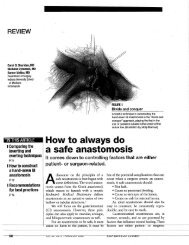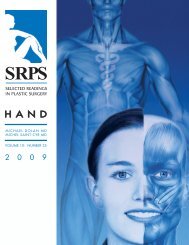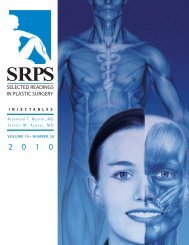Craniofacial Anomalies, Part 2 - Plastic Surgery Internal
Craniofacial Anomalies, Part 2 - Plastic Surgery Internal
Craniofacial Anomalies, Part 2 - Plastic Surgery Internal
Create successful ePaper yourself
Turn your PDF publications into a flip-book with our unique Google optimized e-Paper software.
visceral arches, the intervening first pharyngeal pouch<br />
and first branchial cleft, and the primordia of the<br />
temporal bone. 38<br />
Originally craniofacial microsomia was thought to<br />
represent a progressive skeletal and soft-tissue deformity<br />
that worsens over time, 39 but subsequently<br />
Polley 40 assessed longitudinal cephalometric data from<br />
26 patients with unoperated hemifacial microsomia<br />
and demonstrated that the condition is not<br />
progressive. These findings were further confirmed<br />
by Kearns et al 41 in 67 subjects. The disorder varies<br />
widely in presentation and may range from simple<br />
preauricular skin tags to composite mandibular and<br />
maxillary hypoplasia. Its management depends on<br />
the severity of the defect and the functional and<br />
aesthetic reconstructive needs. 42-46<br />
Pruzansky 44 described three types of mandibular<br />
deficiency in craniofacial microsomia according to<br />
the anatomical area affected (Table 2).<br />
This classification was modified by Mulliken and<br />
Kaban, 47 who subdivided Type II into Type IIA, in<br />
which the glenoid fossa-condyle relationship is maintained<br />
and the TMJ is functional, and Type IIB, in<br />
which the glenoid fossa-condyle relationship is not<br />
maintained and the TMJ is nonfunctional.<br />
Munro’s 42,44 classification extended the skeletal<br />
anomaly to include the orbit. This system aims at<br />
providing a basis for surgical reconstruction and consists<br />
of five types denoting increasingly severe hypoplasia<br />
of the facial bones (Table 3). Isolated microtia<br />
is considered to be a microform of craniofacial<br />
microsomia. 48<br />
Meurman 46 recognizes three grades of auricular<br />
deformity, as follows: Grade I: distinctly smaller,<br />
SRPS Volume 10, Number 17, <strong>Part</strong> 2<br />
malformed auricle but all components are present;<br />
Grade II: only a vertical remnant of cartilage and<br />
skin is present, with atresia of the external meatus;<br />
Grade III: complete or nearly complete absence of<br />
the auricle.<br />
David and colleagues 49 proposed a multisystem<br />
classification of hemifacial microsomia in the TNM<br />
style. The physical manifestations of hemifacial<br />
microsomia are graded according to five levels of<br />
skeletal deformity (S1–S5) equivalent to the Pruzansky<br />
classification for S1-S3, plus S4 representing orbital<br />
involvement and S5 representing orbital dystopia.<br />
Auricular deformity (A0–A3) is similar to the classification<br />
described by Meurman. Tissue deficiency<br />
(T1–T3) is graded as mild, moderate, or severe. The<br />
SAT sytem allows a comprehensive and staged<br />
approach to skeletal and soft-tissue reconstruction.<br />
Early macrostomia repair (1–2 months of age)<br />
yields excellent functional and cosmetic results. 50<br />
More extensive reconstruction, including composite<br />
correction in moderate to severe deformity, is reserved<br />
for early childhood (age 5–6) but should not wait<br />
until facial growth is complete. 39,42–44,51–54 The mandible<br />
is usually corrected first in the hope that repositioning<br />
the jaw will unlock the growth potential of<br />
the functional matrix to allow normal growth of the<br />
mandible 55,56 and release abnormal growth tendencies<br />
of the maxilla.<br />
In mild cases, Posnick prefers to wait for skeletal<br />
maturity, and employs traditional orthognathic<br />
surgery to achieve favorable aesthetic results. 50 Distraction<br />
osteogenesis provides excellent correction<br />
in cases of mandibular deformity up to Type IIB. 57,58<br />
In cases of Type III deformity, a costochondral<br />
TABLE 2<br />
Mandibular Deficiency in <strong>Craniofacial</strong> Microsomia (Pruzansky)<br />
5






